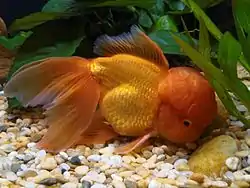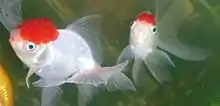Oranda
An oranda is a breed of goldfish characterized by a prominent bubble-like "hood" on the head. The headgrowth or hood (also known as wen or crown) may be a prominent growth on the top of the head (cranial region) or may encase the entire face except for the eyes and mouth.[1][2][3]
| Oranda |
|---|
 |
| Country of origin |
| China |
| Type |
| Veiltailed |
| Breed standards |
| BAS |
When it was first imported from China to Japan it was mistakenly thought to be native to the Netherlands, and was therefore dubbed the "Holland Lionmask", Dutch Lionhead, and "Netherlands Lion Head" (オランダ獅子頭), from which its English name "oranda" derives.
Description
.jpg.webp)


Due to the fleshy outgrowth on the upper half of its head and sides of its face, the oranda has become one of the most popular goldfish. The headgrowth is described as a "wen" by Chinese aquarists.
The oranda is a metallic or matte scaled goldfish that is similar in appearance to the veiltail. It has a large, long and deep body accompanied by a long quadruple tail. This four-lobed and contracted tail normally spreads out broadly when the oranda stops swimming. The back does not rise up to form a ryukin-like hump.[2][3]
Orandas are available in a variety of colors, most often orange, red, red-and-white, red-and-black, black, blue, chocolate, bronze, white or silver, black-and-white (panda-colored), red-black-and-white (tricolor), and calico colors.[4][2][3]
The headgrowth of young fry may take one to two years to develop.[4][2] The oranda can reach 20 to 31 centimeters (8 to 12 inches) in length.[2][3] Sometimes the wen grows enormously covering the eyes of the goldfish. Due to this, the eyesight may become limited or even blind. Special care should be given to the wen because it is prone to bacterial infections. The Oranda can tolerate temperatures from 17 to 28 °C (65 to 80 °F). More recently blue scale oranda have been developed but these fish are very rare.[5] Oranda goldfish are especially sensitive to cold temperatures, more so than other goldfish.
Variants
- The azuma nishiki is an attractive nacreous-colored form of the oranda.[2]
- The red-cap oranda has a silver body with a prominent red headgrowth on the forehead.[2]
- Chinese breeders have developed telescope eyed orandas, a cross-breeding of the telescope eye and oranda goldfish.[3]
- The hana fusa or pompom oranda is a pompom with a dorsal fin and headgrowth like an oranda. It is a cross between the oranda and a dorsal formed pompom.[2]
- The nagate oranda is a long body oranda developed in Shikoku, south west area of Japan.
- The Apache oranda, is a form of oranda that bares both red and black together. Apaches cannot be named if the blackness only exists on the fin/s.
- The panda oranda is a variety of oranda that is bi-colored or tri-colored, most identifiable by the black-and-white coloration for which it is named.
- The Ingot oranda[6] also known as the Yuan-Bao oranda, is a new Chinese variety of oranda that was crossed from a ryukin with a Ranchu. Its large, short round body has a characteristics of a Ranchu, with its box shaped face containing wen. Its tail is somewhat equal as to the ryukin, though generally short-finned ingots are very popular and widely produced today.
- The Chakin (チャキ) also named as the chocolate oranda, is a colored variant of an oranda. It has brownish scales with a color like that of chocolate. Its actual name means Tea fish or Tea goldfish in Japanese.[7]
- The Seibungyo (成分魚) or Seibun is a blue oranda, named for its bluish grey silver coloration. The "blue" is combined with both black areas on the outside skin, and black from the inside layers, to form a blue-like sheen.[8]
- The black oranda is a currently developed color variety that is crossed from the black moor.
- The jade seal oranda is a type of color pattern that consist of a white, clear cap on its head, and the rest of the body is red or orange.
Special care
Orandas are sensitive to low water temperatures and can be kept with other goldfish.[2] If their wen grows too much, it may hinder vision, so it is advised to keep them with other goldfish with similarly poor vision in order to make sure that they do not starve because of the able-sighted competition. Some aquarists prefer to trim the wen off of the goldfish by using a scissor to prevent blindness and doused with peroxide to prevent from damaging essential areas around the face or body.[9] Their wen is also susceptible to injury from rough objects placed in their residence.
References
| Wikimedia Commons has media related to Oranda. |
- BAS: Oranda
- Andrews, Chris. An Interpet Guide to Fancy Goldfish, Interpet Publishing, 2002. - ISBN 1-902389-64-6
- Johnson, Dr. Erik L., D.V.M. and Richard E. Hess. Fancy Goldfish: A Complete Guide to Care and Collecting, Weatherhill, Shambala Publications, Inc., 2006. - ISBN 0-8348-0448-4
- Koko's Goldfish World: Oranda, KokosGoldfishWorld.com, retrieved on: 3 June 2007.
- Free Information Keeping Oranda Goldfish
- "Ingot Oranda". goldfishnet.com. Retrieved 18 October 2018.
- "Chocolate Oranda". Japanese Goldfish Catalog.
- "Seibun". Japanese Goldfish Catalog. Retrieved 18 October 2018.
- Rand, Brenda. "Wen Trim or Removal". Goldfish Emergency. Retrieved 18 October 2018.
External links
- Varieties of Goldfish -About Oranda
- Varieties of Goldfish -About Calico Oranda
- Varieties of Goldfish -About Blue Oranda(Seibun)
- Varieties of Goldfish -About Chocolate Oranda
- Varieties of Goldfish -About Redcap Oranda